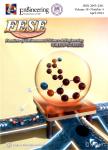Performance and mechanistic study on electrocoagulation process for municipal wastewater treatment based on horizontal bipolar electrodes
作者机构:State Key Laboratory of Urban Water Resource and EnvironmentHarbin Institute of TechnologyHarbin 150090China Sino-Dutch R&D Centre for Future Wastewater Treatment Technologies/Beijing Advanced Innovation Center of Future Urban DesignBeijing University of Civil Engineering&ArchitectureBeijing 100044China Nanyang Environment and Water Research InstituteNanyang Technological University1 Cleantech LoopCleanTech OneSingapore 637141Singapore
出 版 物:《Frontiers of Environmental Science & Engineering》 (环境科学与工程前沿(英文))
年 卷 期:2020年第14卷第3期
页 面:39-48页
核心收录:
学科分类:083002[工学-环境工程] 0830[工学-环境科学与工程(可授工学、理学、农学学位)] 08[工学]
基 金:Project supported by the National Natural Science Foundation of China(Grant Nos.51822806,51678184 and 51761145031) Fundamental Research Funds for the Central Universities(Grant HIT.BRETIV.201905)
主 题:Electrocoagulation Bipolar electrodes Municipal wastewater Simulations
摘 要:The design of electrodes is crucial to electrocoagulation process(EC),specifically,with respect to pollutant removal and energy *** EC,the mechanisms for interaction between different electrode arrangement and electrode reactions remain *** work presents an integrated EC process based on horizontal bipolar electrodes(BPEs).In the electrochemical cell,the graphite plates are used as driving cathode while either Fe or A1 plates serves as driving anode and *** BPEs are placed horizontally between the driving *** municipal wastewater treatment,the pollutant removal efficiency and energy consumption in different configurations of twodimension electrocoagulation(2D-EC)system with horizontal BPEs were *** removal efficiency of turbidity,total phosphorus and total organic carbon increased significantly with the number of *** that the energy consumption for TP removal decreased by 75.2%with Fe driving anode and 81.5%with A1 driving anode than those of 2D-EC,*** addition,the physical field simulation suggested the distributions of potential and current in electrolyte and that of induced charge density on BPE *** work provides a visual theoretical guidance to predict the distribution of reactions on BPEs for enhanced pollutant removal and energy saving based on electrocoagulation process for municipal wastewater treatment.



